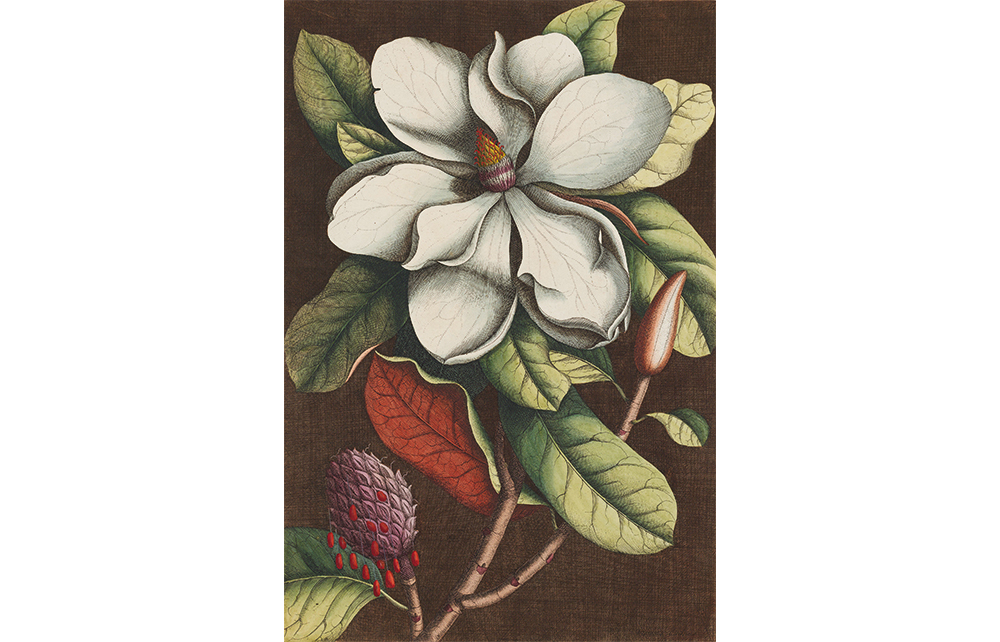I am an absolute sucker for a handsome reproduction of a rare and highly illustrated natural history, preferably more than two centuries old. This may possibly be a niche interest, but Catesby’s Natural History was pronounced a wonder when it was first published and is a wonder still.
Mark Catesby was ‘a procurer of plants’, sponsored by a group of rich, curious patrons, including William Sherard and Sir Hans Sloane, to explore and record the flora and fauna of the most southern of the Thirteen Colonies – the Carolinas and Florida, as well as the Bahamas Islands. He made several perilous trips in the 1720s, sketching his subjects live, and completing paintings in England. He finally published his text and 220 hand-coloured plates in 1747. His is not a household name, but his contribution deserves acclaim, and not simply because he introduced that denizen of the larger sub-urban garden, the Indian Bean Tree, Catalpa bignonioides, into European cultivation.
The interest of these plates lies partly in the meticulous care taken – even if they are not always strictly scientifically accurate – and partly in the artistic presentation, with most of the paintings depicting a felicitous mix of indigenous animals, insects and plants. The evil-looking coloured snakes twining through flowering lianes make me shiver, but the birds, from blue jays to belted kingfishers, and the exotic plants, including the ‘lily thorn’ named after the artist, are always appealing and sometimes awe-inspiring.
This is an important record of the natural history of sub-tropical North America,100 years after the first European settlements but before the American Revolution. The re-publication of the second edition of 1754, held in the Bodleian Library in Oxford, produced by its publishing arm at £50, and with several illuminating chapters by Stephen A. Harris, Druce Curator of Oxford University Herbaria, is an event to celebrate.
There is less to celebrate in Todd Longstaffe-Gowan’s Lost Gardens of London (Modern Art Press, £25), despite its fine quality. The book helpfully augments the recent work done by garden historians on the capital’s gardens and green spaces, retrieving a selection of those that are ‘lost’ with a lively text and revealing sketches, plans, photographs and paintings. It should fascinate any Londoner curious about what once lay beneath their feet and intrigue those of us who visit the capital but rarely. Who knew, for example, that there was a short-lived racecourse in Notting Hill in early Victorian times? The famous 18th-century Vauxhall Gardens get due coverage, but the East End version, the New Globe Tavern, where punters were treated to balloon ascents during firework displays, is also described. No health and safety executive then.
Ultimately, however, this reader was left with the melancholy conviction that change has not always meant improvement; the poignant image of the vicar of St Pancras chained to a plane tree due to be felled to make way for HS2 is emblematic of the casual barbarism that has too commonly been visited on London’s green spaces down the centuries.
No doubt that image would horrify Susie White, the author of Second Nature: The Story of a Naturalist’s Garden (Saraband, £12.99). An artist and erstwhile professional nurserywoman living in a remote valley in the North Pennines (lucky thing), she is also a dedicated naturalist who has troubled to get to know her garden and landscape intimately. The value of such a book is that it deepens the reader’s appreciation of their own garden. My gardening has certainly been enriched by knowing that mothercare spiders anchor their nests in Eryngium tops and that the furry leaves of Stachys lanata provide nesting material for wool carder bees. However, I could have done with a garden plan, and the author could probably have done without the typos.
More garden tour than memoir is Gardening with Colour at Coton Manor (Pimpernel Press, £30), by Susie Pasley-Tyler, who, with her husband Ian, took over the house and ten-acre garden in Northamptonshire from his father in 1991 and has made it a place of pilgrimage for keen gardeners. I know and admire the Pasley-Tylers, so you must aim off for that, but the garden was voted ‘nation’s favourite’ in a poll in 2019, so you need not take my word for its quality. Susie is well known for her unusual sensitivity to colour, form and texture, coupled with a deep practical knowledge and understanding of the dynamics of plant growth. The garden is open to visitors from April till September. I saw it in its final week this year and it was still flowering fit to bust. Achieving that requires exemplary care and attention to detail. If you want help in putting plants together successfully, read this book. It has a necessary garden plan, and masses of photographs taken by the author.
These writers, as you would expect, understand how complex is a garden’s ecology; but that is not a given for all gardeners, hence the value of The Science of Garden Biodiversity: The Living Garden by Julien Doberski (Pimpernel Press, £9.99). The author is a retired university lecturer in ecology, whose mission is to encourage us, with the help of solid scientific data, to open our minds to how rich our gardens are in biodiversity and how we can discover some of that richness – not all of which is even visible to the naked eye.
It’s hard now to imagine that, in the early days of the science of ecology, gardens were not much studied, being thought too artificial and degraded. However, thanks to Jennifer Owens’s brilliant, pioneering investigative work on her Leicester garden over 30 years, published in 2010, we know how blinkered a view that was. Gardens can boast astonishing variety, especially of insects, chiefly because they comprise so many habitats. Doberski helpfully describes how insects can be detected, captured, identified and promoted. This book also dispels the myth that only native plants promote biodiversity, which means ‘rewilding’ gardens. No, it doesn’t, and this slim paperback tells you why not.







Comments